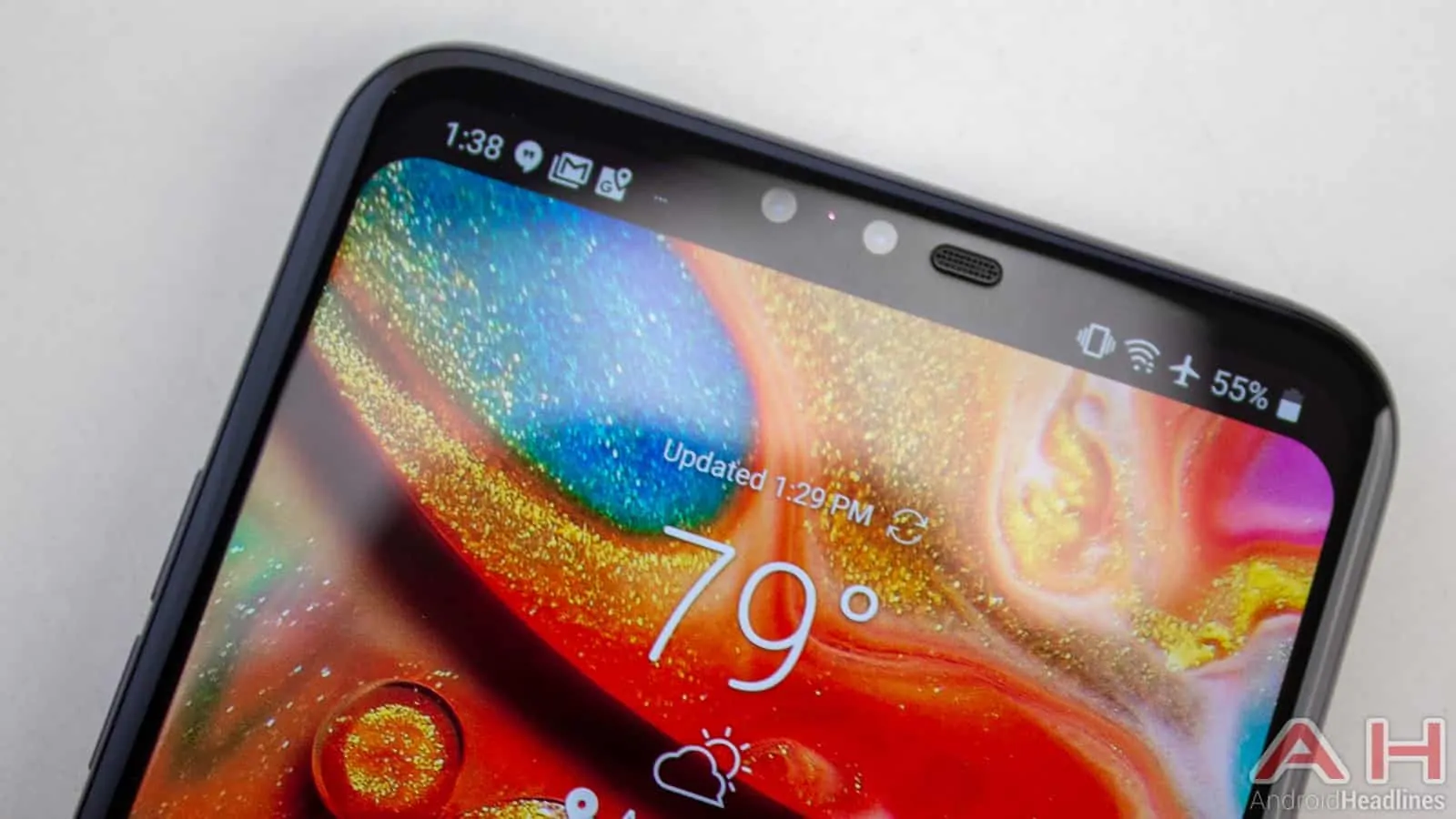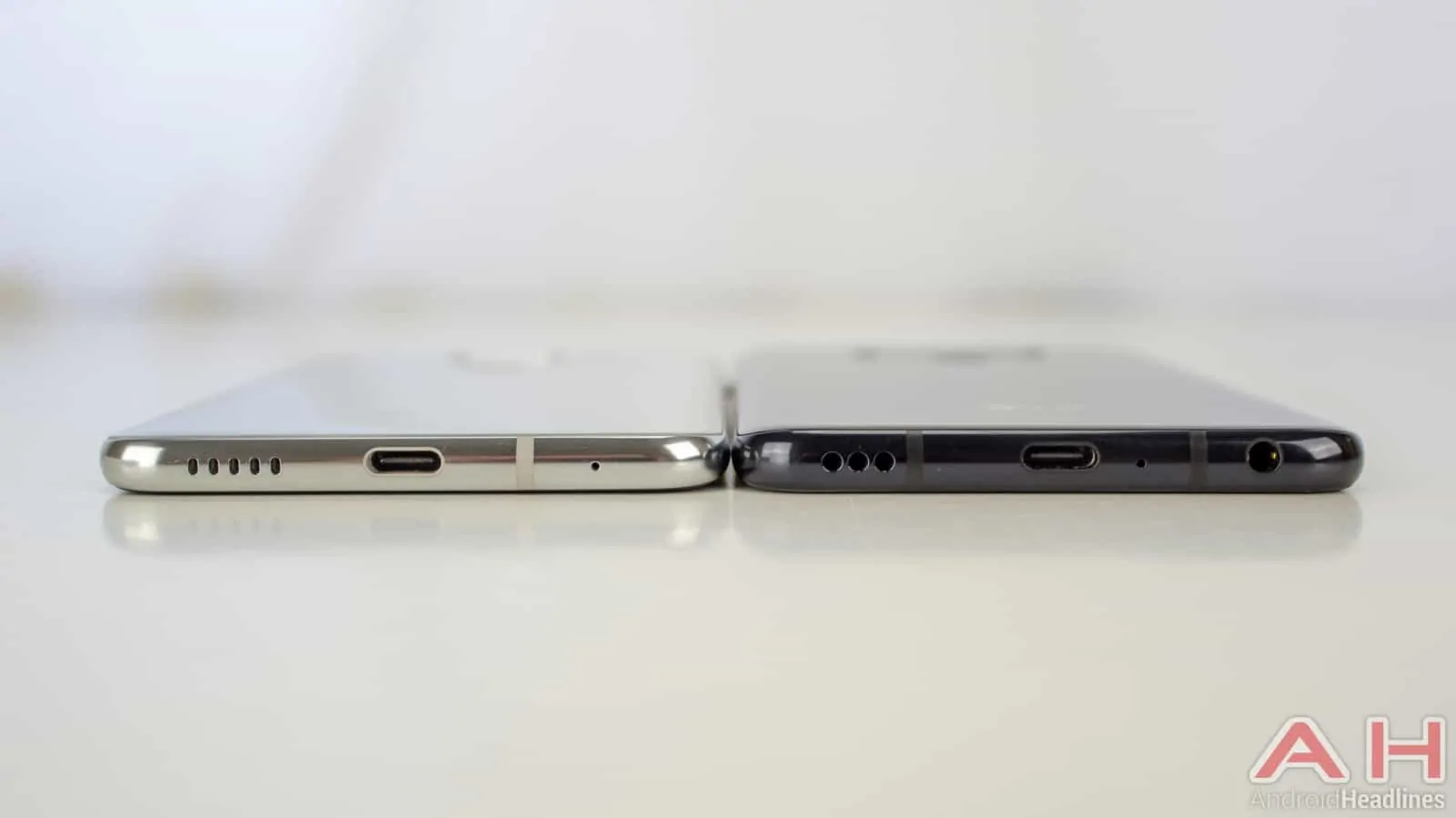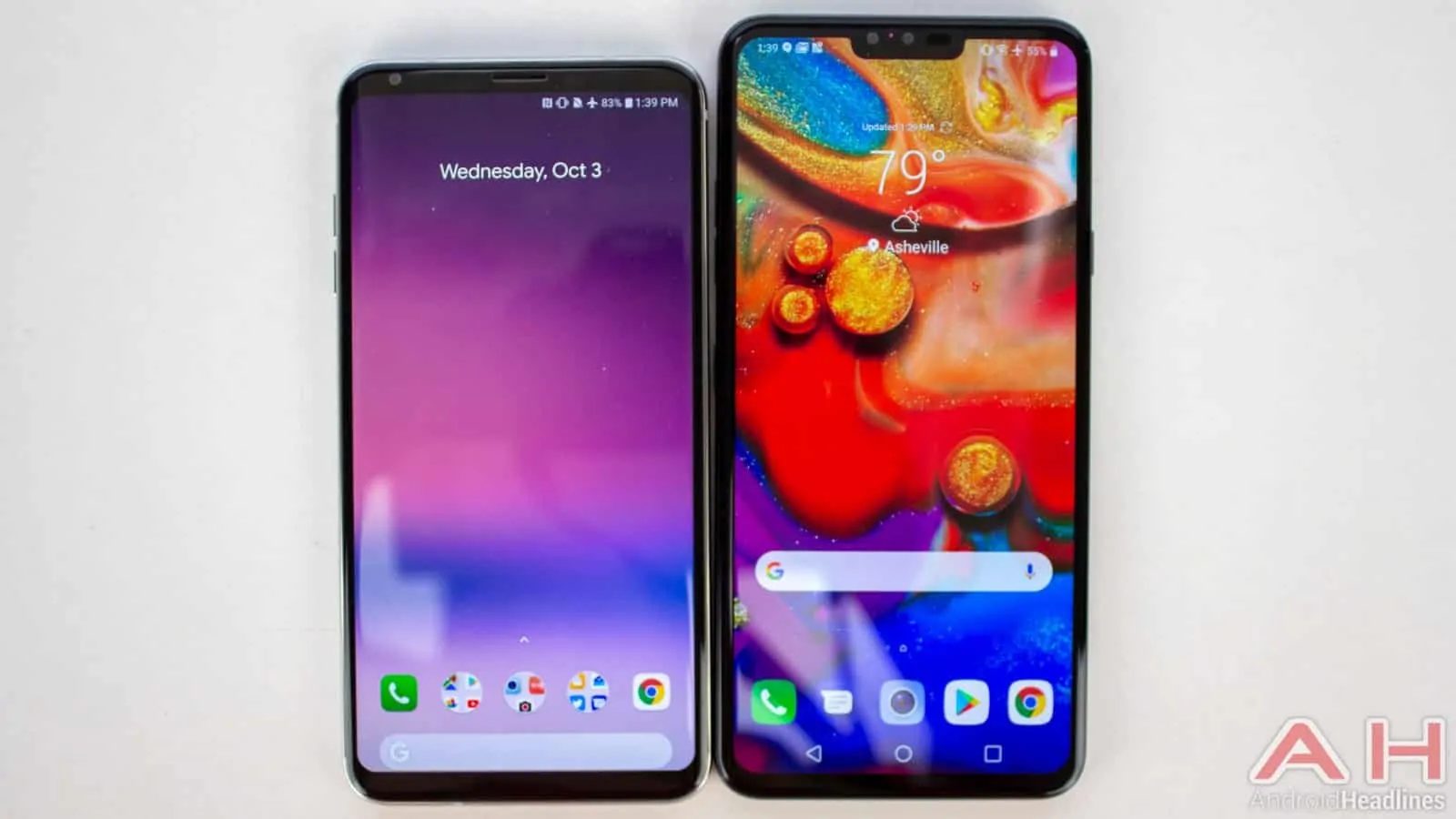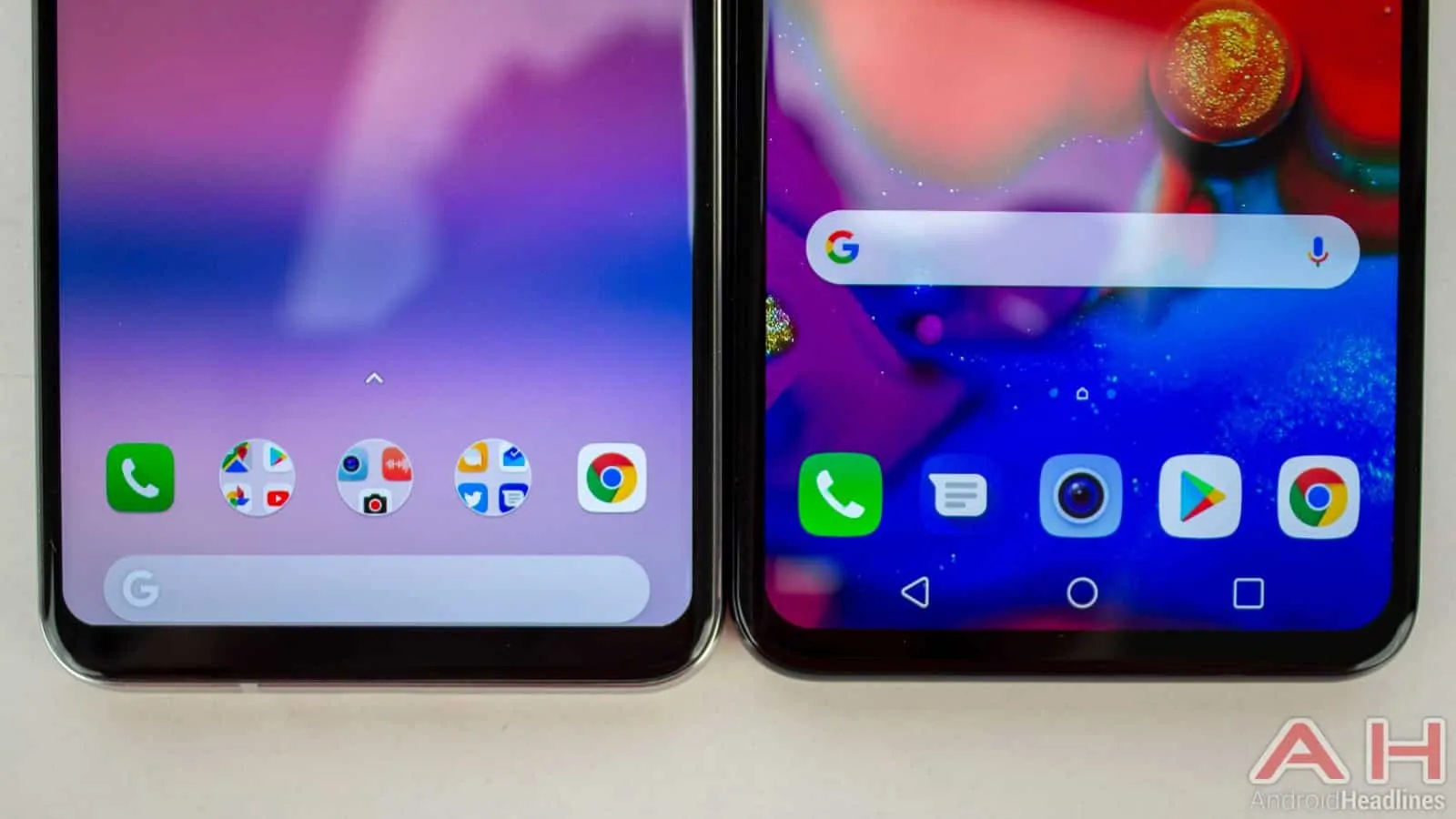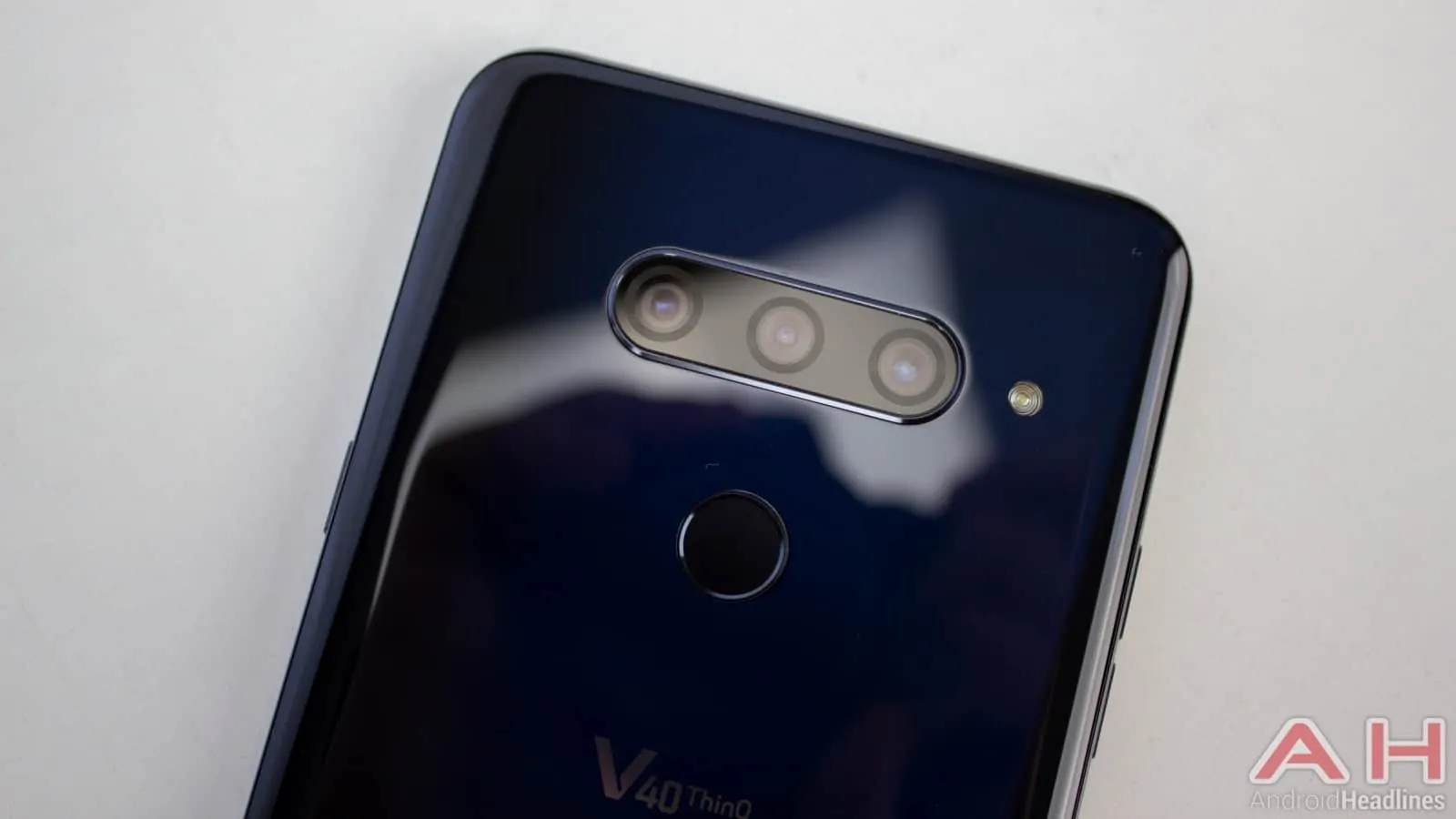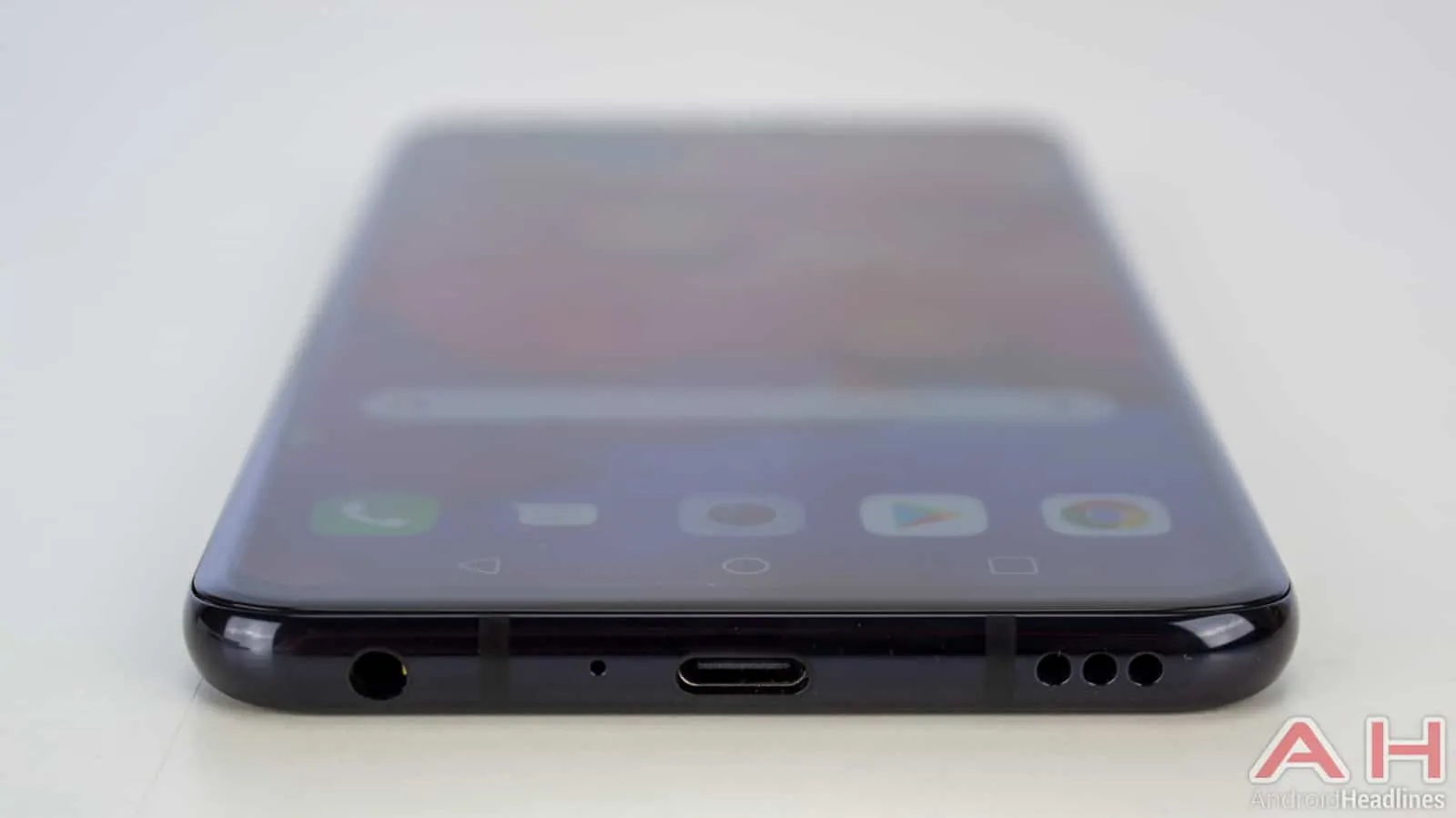The content creators’ phone gets even more creative
LG’s V-series started out as a bit of an experimental device, evolving over the years into what has become known as the “content creators” phone. Last year we lauded the LG V30 for its amazing manual modes and control, even going so far as to replace our existing video equipment for our YouTube channel with V30’s. This year LG is doing more than just beefing up specs, it’s adding in two more cameras, totaling 5 cameras on the device, and introducing a slew of unique new features to go with these. The LG V40 ThinQ takes what we loved about the V30 and ups the ante in every single way, but does it make sense for more than just content creators? Let’s take a look.
Video Review
Specs and Unboxing

LG is launching the V40 ThinQ in mid-October on all US carriers, as well as an unlocked version available worldwide. The device is expected to sell for around $800 at each carrier, but pricing is likely to be slightly different depending on your carrier of choice. At this time of writing, International pricing is yet to be revealed, however, LG states that the phone will also be available in Europe and South Korea. Colors differ per region, as the US will only receive the Black and Blue colors, while other regions get all four colors: Black, Blue, Red and Gray. On the front is a larger 6.4-inch Quad-HD+ HDR10 OLED display (537 PPI), up from the 6.0-inch display on the V30. Much of this display increase comes in the reduced bezels on top and bottom, with a smaller chin at the bottom and a notch up top.
The V40 ThinQ is larger than the V30 in every way, with a height of 158.7mm, a width of 75.6mm, a thickness of 7.6mm, and a weight of 168g. This compared to the V30, which was 151.7mm high, 75.4mm wide, 7.4mm thin and 158g in weight. A Qualcomm Snapdragon 845 SoC handles the processing side of the house, with 6GB of RAM and 64GB of storage. MicroSD cards are supported, as well as dual-SIM on most models. A non-removable 3,300mAh battery sits inside the IP68 water and dust resistant chassis, and LG is still providing users with both a USB Type-C port (USB 3.1 speeds) and a 3.5mm audio port (32-bit DAC) as well. The Boombox speaker from the LG G7 ThinQ has made its way to the V40 ThinQ, increasing the quality of the audio experience significantly over the already quality single speaker on the V30. The V40 ThinQ ships with Android 8.1 Oreo.
LG is changing up its camera game with the V40 ThinQ in some incredibly significant ways. Starting with the main sensor, we’re looking at a 12-megapixel sensor with 1.4μm size pixels; a 40% increase in pixel size over the V30, but a reduction in the number of pixels as well (down from 16-megapixel). This camera features an f/1.5 glass lens with 78-degree FoV. The wide-angle lens is using the same Sony IMX351 sensor as the LG G7 ThinQ, a 16-megapixel sensor with pixel binning support for ultra-bright wide-angle shots at a 107-degree FoV with an f/1.9 rating. A third lens is also added to the back this time, a 12-megapixel sensor, identical to the main camera, but with an f/2.4 telephoto lens that sports a 45-degree FoV (2x optical zoom). Up front you’ll find two cameras as well, just like on the original LG V10, sporting an 8-megapixel sensor with 71-degree FoV, and a 5-megapixel wide-angle sensor at 97-degree FoV.
There’s not a whole lot of extra pack-ins in the box, but LG does include a pair of 3.5mm earbuds with a gorgeous braided cloth cable. Outside of this, you’ll find a fast charging power adapter (9v/1.8a), USB Type-A to USB Type-C cable, SIM tray ejector tool, and a set of manuals and warranty pamphlets. Something LG does better than almost any company is its 2-year warranty that ships with every phone, providing customers with peace of mind of their devices for a full 2 years after purchase. LG calls this the Second Year Promise, in which they guarantee a full replacement of any defective phone for no cost or deductible.
Display

Last year we saw a huge jump in quality when LG made the shift from LCD on the G6, to OLED on the V30. This marked the beginning of LG’s big mobile rollout of OLED displays, as LG has begun to supply panels for more than just its own phones over the past year. There were some quality issues with the V30’s panel at times though, and we saw that LG’s panels were less than stellar when they were placed on the Google Pixel 2 XL last year as well, but subsequent shipments of both phones have shown LG’s display quality has improved significantly in just a few months of process revisioning. While LG peculiarly decided to use an LCD on its recently released G7 ThinQ, they’ve stuck with OLED displays on the V35 ThinQ, and now the V40 ThinQ as well.
Last year the biggest complaint about the OLED display used on the V30 was its overall “dirty” look, where pixels wouldn’t all display the same brightness or exact shade of color. Much of this was attributed to LG’s “inexperience” with OLED manufacturing at this level, and while LG’s TVs remained top-notch in their quality, their phone OLED panels suffered from this issue in other phones like the Google Pixel 2 XL as well. This year it’s clear LG has fixed the issues they had with quality control of their OLEDs, as the display on the V40 ThinQ is among the finest OLEDs you’ll find on the market. The display can get super bright and is easily viewable in sunlight, and can also get so dim it’s almost hard to see, even in a pitch-black room, giving this one an incredible range of brightness for all levels of ambient light.
That being said, it’s not quite as bright as the LCD panel on the G7, which was designed specifically for ultra brightness at 1,000 nits, but unless you just need an ultra-bright display, every other measurement of display quality favors the V40’s OLED display over the LCD display on the G7. Colors pop and just look more natural on the V40, thanks to the infinite contrast ratio of OLED panels, which deepen colors by providing black levels that are truly black, not a dark shade of gray. This makes colors look more realistic, as they don’t have that slightly faded look to them, and helps make the screen look more like a quality printing than what many are used to seeing from a digital display.
Motion resolution and pixel persistence rates are also perfect on OLEDs, as they don’t lose resolution during movement or feature ghosting and pixel trailing in high-contrast scenes with movement. The perfect black levels that OLEDs can deliver are most useful in “hiding” the notch, which is enabled by default this time. LG introduced a display notch on the G7 ThinQ, and by default, left the default color changing behavior of the status bar alone, making the notch taken out of the display rather obvious. While the option to “hide” the notch by making the status bar black at all times was available, black levels aren’t truly black on LCDs, and as a result, didn’t do a great job of actually hiding this eyesore. On the V40, LG enabled this “hidden notch” mode by default, and since pixels are actually off on an OLED when displaying the color black, the display itself looks no different from the black bezel or notch that takes up a bit of space through the status bar up top.
As a result, the status icons up top appear to be nestled right into the bezel around the top, making it appear more like the “second screen” that was present on the V10 and V20. That being said, it doesn’t actually act like the second screen did on those phones, despite LG still calling it that. This is quite literally just the status bar, as it is on every other Android phone, but at the least LG offers the actual second screen functionality in the floating bar that’s present on both the V30 and G7, as well as the V40. It’s a way to quickly launch 5 favorite apps, communicate with 5 favorite contacts, or perform a handful of quick actions as well. It’s not as robust as similar functionality offered on Samsung or HTC’s phones, but it’s still better than most other phones on the market when it comes to these kinds of quick-access features.
Hardware and Build

LG’s hardware has evolved significantly over the past year, with the V30 being the first to signal in the significant change that we were going to witness in that short span of time. LG went through a number of evolutions throughout the years, once focusing on premium natural materials like leather, to trying out metal phones, and finally resolving to a glass body with metal trim, as we have now. Size has become a bit of a burden on several users though, and while last year’s devices featured larger screens than ever, the bodies of the G6 and V30 were right in line with the sizes of previous generation devices. This year we’ve seen an increase in size for screens and phone sizes, and the V40 ThinQ is no different. The V40 is 7mm taller, 0.2mm wider and 0.2mm thicker than the V30, as well as being 10g heavier. It’s still much lighter than most flagships, making it feels more elegant and sleek, and the giant 6.4-inch screen doesn’t feel anywhere near that large on this elegant frame.
7mm taller is still pretty impressive given the significant increase in screen size, a screen that’s 0.4-inches larger than the V30, which has been offset partially by a smaller chin, but mostly by the advent of the notch up top. The extra 0.2mm of thickness doesn’t come in the form of a larger battery, rather it’s there in order to provide the small space needed to create the Boombox resonance speaker we saw debut on the LG G7 ThinQ. This without sacrificing battery size or removing quality-of-life features like Qi wireless charging. LG’s build quality has significantly increased over the past year, and while the G6 felt like the beginning of a new era for LG, the V30 was the true revolution in hardware and design for the company. This feels very much like a modified G7, not a refined V30. This isn’t a bad thing, but it definitely feels more like a super-charged G7 in its design rather than a refined V30.
LG continues to utilize the absolute best vibration motors in the industry, something that has to be felt to be truly understood. These vibration motors are absolutely sublime to use and feel absolutely incredible in any situation. LG utilizes them for creative ringtone effects as well, vibrating to a tune in multiple different ways and intensities, and this happens throughout the UI too. Swipe away a notification and you’ll feel a subtle slide rumble to coincide. Tapping on buttons in the UI emits a slight click feeling that’s solid without feeling harsh. Interestingly enough the buttons on the phone are small and barely protrude from the body, and in some situations, can be slightly difficult to feel against the smooth edge. These buttons require less actuation force to press, which is quite a bit different from the hard click required to press the volume buttons on the V30. There’s no wobble to them, and they almost feel like the press of a home button on older Samsung phones.
Security and Performance

LG is sticking with its tried-and-true rear-facing fingerprint scanner on the V40 ThinQ, but just like the G7, it’s separate from the power button. This is among the fastest and most accurate fingerprint scanners on the market, and it’s certainly a positive thing that LG hasn’t messed with success. Other OEMs have begun moving towards in-glass fingerprint scanners or ditching the fingerprint scanner entirely in place of facial recognition, but many prefer the speed and accuracy of a more traditional fingerprint scanner, and for large phones, a rear-facing one is generally more comfortable to use than other configurations. LG’s facial and voice unlock is still powered by Sensory’s Truly suite of secure biometric recognition, which means highly secure and accurate biometric recognition even when utilizing just the front-facing camera. Sensory’s technology is powered by machine learning and aims to recognize a user via organic elements of the face rather than simple facial structure, and works unbelievably quickly too.
The V40 ThinQ utilizes Qualcomm’s latest mobile processing technologies but isn’t using hardware any different from what we saw in the LG G7 ThinQ’s release just a few months ago. This is due to the industry at large not having anything new for Fall release phones, and as such, all flagships this year are going to have incredibly similar specs and performance levels, depending entirely on the amount of RAM and the optimization levels built into the Android skin on each device. LG’s skin has long been quick and snappy, and unlike some other OEMs with heavy skins that lag over time, never slows down over the life of the phone. As we still utilize the LG V30 for our YouTube filming process here at Android Headlines since the review period began this time last year, it’s safe to say this phone won’t be slowing down over time. LG also offers some gaming tools that help control battery life and performance by allowing users to reduce framerate or resolution of games, as desired.
Wireless Connectivity, Sound and Battery Life

LG primarily sells their phones through carrier channels, and as such, many of them are locked to the original carrier the phone was purchased at. This may vary between regions and carriers, but all V40 ThinQ units feature identical processors and cell radios, meaning the phone should work just fine in every region it’s sold in, so long as it has been carrier unlocked. Since this phone is sold through carrier channels, you can rest assured that all advanced carrier options, such as Voice over LTE and WiFi Calling, will be supported out of the box without any need for tinkering. LG is also packing in 4×4 MIMO radios in the V40 ThinQ, ensuring the fastest LTE speeds from your favorite network.
As a content creator’s phone, sound is paramount to the experience of creating quality content via video or sound recording. While many OEMs are dropping the 3.5mm audio jack and reducing overall related features, LG is sticking with its guns when it comes to quality sound output and recording by providing the highest quality sound output on the market through its quad-DAC system, as well as supporting USB Type-C digital audio and ultra high-quality Bluetooth audio as well. LG’s high-resolution mics, located around the body, record in 3D spatial audio as well as HD-quality audio at the same time. Only the HTC U12+ offers something the V40 doesn’t, with its directional recording abilities when zooming into video, but that phone is unable to record both in spatial and HD audio at the same time, giving each phone one advantage over the other.
LG has improved the speaker on the V40’s body considerably when compared to the V30, as it features the same Boombox resonance speaker from the LG G7 ThinQ. The single bottom-firing speaker sounds similar to the V30 when holding the device in terms of volume and quality, but cupping the device is no longer needed in order to hear things well. Instead of just relying on the sound being output through the speaker grille at the bottom, LG has built a resonance chamber into the phone’s body, which adds 0.2mm to the overall thickness of the device but allows the sound to travel throughout the glass and aluminum frame to amplify the volume considerably. This is heightened when placing the phone on a surface, especially a wood one, as the sound will also resonate through that material, further amplifying and deepening the sound quality. It’s not going to replace stereo or front-facing speakers when holding the phone in a hand, but it offers better quality and performance when placing it down to listen to music, so the positive effects will differ from person to person depending on how they listen to audio via their phone.
Most people will find that the battery on the V40 ThinQ barely lasts through a day on a full charge, and this is right in line with what we found on the G7 ThinQ as well. What’s surprising is that this battery is 300mAh larger, yet we didn’t see much of an improvement in overall battery life, if any at all. This display is 0.3-inches larger than the G7, a 5% increase in size, while the battery is 10% larger than the G7’s. With that said, it should be expected that the battery life on the V40 is about equal to the G7 given the rest of the hardware and software similarities, and the same goes with charging. This phone supports 10W fast wireless charging, as well as Qualcomm’s new QuickCharge 4.0 spec, however, the phone only ships with a QuickCharge 3.0 brick. This means you can expect a full charge from empty in under 2 hours, or about a 50% charge in 30 minutes. QuickCharge 4.0 will up this to about a 50% charge in 15 minutes.
Software

LG is shipping the V40 ThinQ with Android 8.1 Oreo instead of the recently released Android 9 Pie. This marks the second year in a row that LG is launching its latest phones with an older version of Android, something that’s a bit of a far cry from the LG V20, which was the first phone to ship running Android 7.0 Nougat. Not launching with the latest version of Android isn’t all negative though, especially not when considering how many controversial changes Google has made in Android 9 Pie, and the wait to see what LG decides to do here may be well worth it in the end. LG’s Android skin has been long overdue for a total overhaul for some time now, as it has only received minor tweaks and updates throughout the years.
That being said, there’s nothing wrong with LG’s Android skin, in fact, it’s one of the faster skins out there, and quite feature-rich at that. The biggest downside to no major updates here is of course not having a hallmark software feature to use out of the box, leaving the V40 ThinQ feeling a bit stale when taking all the new camera options out of the equation. LG offers plenty of options that can’t be found on stock Android 8 Oreo, or even Android 9 Pie, despite running the year-old Android 8 Oreo out of the box. LG features an awesome “Context Awareness” feature that can automatically change the sound profile, Bluetooth and Wifi connectivity options when you get to a certain location (home, work, etc), or can be set to launch a specific app when connecting to a certain Bluetooth device or when headphones are connected.
Camera Hardware and Software

LG has created one of the more interesting camera hardware configurations in recent memory, but it’s doing so in a more straightforward way than some other OEMs. OEMs like Huawei utilize a monochrome camera to help beef up dynamic range and low-light detail to the main sensor, but LG is utilizing three very different lenses for each of its three cameras, two of which share the same sensor. There are also two separate Qualcomm Image Signaling Processors (ISPs) here. The main and telephoto sensors are identical and share a single ISP, while the wide-angle sensor is different and has its own ISP. Those main and telephoto sensors are the same Sony 12-megapixel sensors with 1.4μm pixels. This main sensor is behind an f/1.5 78-degree angle glass lens, while the telephoto camera utilizes a 45-degree FoV (2x optical zoom) f/2.4 lens. The wide-angle sensor is the same Sony IMX351 as the LG G7, which was the main camera sensor from last year’s LG V30. This 16-megapixel sensor sports 1.0μm pixels and a wide-angle f/1.9 lens with 107-degree FoV, which is 13 degrees narrower than the ultra wide-angle lens on the V30.
The biggest advantage to switching out the wide-angle sensor from the 13-megapixel Samsung S5K3M3 last year isn’t just resolution, it’s the ability this sensor has to perform what’s known as “pixel-binning,” which virtually combines pixels to bring in more light in low-light situations. The two other sensors here also feature significantly enhanced low-light abilities thanks to 40% larger pixels, and of course, having a telephoto lens means the V40 will have better zoom detail while using the viewfinder’s zoom slider than other LG phones on the market. Along the front is a pair of cameras, harkening back to the original LG V10 days, with a main 8-megapixel sensor behind a 71-degree angle lens, and a second 5-megapixel sensor behind a wide-angle 97-degree FoV lens. Additionally, LG has upgraded the video recording to 4K at 60FPS, while the Slow-Motion mode is seeing an increase in quality, up to 1080p at 240FPS from 720p last year.
LG is able to utilize all three rear-cameras as once in a brand new mode called Triple Shot, which will give users the ability to review all three photos and choose their favorite from the pack, or even turn all of them into a short movie clip. There’s no delay when pressing the shutter button, as the picture is captured instantly, however, there’s a bit of processing time on the back-end, meaning you’ll have to wait several seconds before taking another Triple Shot. Other shots can be made during this time though, so if you switch to another mode, you’ll be able to utilize that mode while the phone finishes processing the Triple Shot.

Some significant improvements come in the form of the ability to not only record 4K videos at 60FPS now but also to choose HDR10 recording as well. Last year we saw an intro to HDR-lite, if you will, with LG’s Cinelog feature in the manual video mode, but this year it’s proper HDR10 spec video from the camera in the manual video mode. This means the ability to view and upload HDR content to supported services, like YouTube, where HDR playback will be supported without having to edit and cut the content manually. 4K60 support in both automatic and manual video mode is also incredibly important for LG, both to keep up with the rest of the market in this category, but also to surpass everyone, once again, in LG’s ability to provide powerful manual video tools for content creators. 4K60 support in manual mode is a godsend for creators who are looking for both high-resolution and high-framerate video in one package, and LG is once again offering the absolute best manual camera on the market, hands down.
Both 60FPS and HDR10 are available in manual video mode, which opens up the ability to not just manually adjust focus or white balance, but also ISO and shutter speed on a whim. These two settings, in particular, are paramount for using the camera in a serious setting. That said there are still some restrictions when using manual video mode that are not just a bummer, they’re a real missed opportunity for LG. First off, that telephoto lens isn’t usable in manual video mode. While using HDR10 you’ll only be able to use the main sensor, not the telephoto or wide angle lenses, which is also a bit of a missed opportunity. LG’s Cine-log has been moved to the Cine Video mode exclusively, so if you’re looking for color grading, that’s the mode to do it in.
LG still integrates its camera deeply with the Graphy service, which provides a “marketplace” of manual modes and presets to choose from. Want more power out of your camera by using the manual mode, but don’t fully understand or aren’t quick enough at the draw to change all the settings yourself? The Graphy marketplace can be browsed for just about any kind of situation that might come up, with presets for things like a brightly lit city street at night, photographing pets or children, indoor situations, perfect portraits and more. Once the preset has been found, it’s a single button click to add it to the camera, and it’ll appear like a sub-mode within the manual camera app mode, giving users a click or two for every situation rather than having to adjust a bunch of sliders at once. You can also make your own presets or tweak the Graphy ones, utilizing them as a base to work from for easy setup. It’s a brilliant set of tools that only LG phones offer, and really helps enhance the prowess of the manual camera experience on the V40 ThinQ.
Another new feature is the AR Sticker mode, which utilizes Google’s ARCore engine to add awesome AR stickers to your photo experience. These are fun 3D animated characters and objects that can be placed anywhere in the scene, and actually work really, really well. Placement is superb and looks realistic, with fantastic animations that make photos come to life. This is similar to what Google does in its camera app’s Playground mode, which was recently rebranded for the Pixel 3. Those are available here and seem to work better than any other AR characters we’ve yet seen on any Android phone, and can add a bit of fun to your shot if you’d like to add these to the mix. There are an absolute boatload of packs to download too, with tons of variety in characters and objects.
The replacement of some of the collage modes from the V30 feels like a positive change overall, but LG’s camera app is starting to feel a bit bloated, not because of too many apps, but because of performance. Sometimes things just take an extra second or two to load, like when Super Bright mode is automatically enabled or disabled, causing a weird pause in the viewfinder. LG has kept its silky smooth transition between zooming as we saw on the V30, but this time around the silky smooth zooming is only between regular and telephoto cameras. Zooming between regular and wide-angle cameras has a definite jolt in the viewfinder as it reinitializes the other camera. Would have been nice to have full smooth zooming between all three cameras, but it’s not the end of the world. What is very frustrating is there’s a weird dichotomy in video recording. Once recording starts you cannot switch between wide angle and standard angle cameras, instead, you’ll have to choose these beforehand. On the bright side the telephoto camera can be used when zooming if you choose either it or the regular camera before hitting record, so at least there’s that.
Camera Results
The wide-angle camera quality is right on par with what’s in the G7, which is to be expected since it’s the same sensor and identical lens. This Sony IMX351 16-megapixel sensor is a spec upgrade over the 13-megapixel Samsung S5K3M3 from the V30. The two advantages here are the 3-megapixel increase in resolution, and the ability for this sensor to use pixel-binning, which combines the pixels in a virtual sense to pull out more light in low light shots. In very low light shots, this new sensor is a clear winner, pulling out more fine detail and more light than the one on the V30. It’s not an earth-shattering performance difference by any means, but it’s definitely better. This advantage decreases in moderate light, where it’s pretty hit or miss as to which sensor is going to do better. Sometimes the V30s sensor is brighter, and sometimes the V40’s is, it’s really super situationally dependent.
Daytime shots regularly show some pretty significantly enhanced dynamic range over the V30’s sensor in most cases though. The only downsides are in the angle of the lens, which we noted about the G7 in that review, as it’s just not as wide as what we enjoyed on the V30, but of course is still considerably wider than most cameras on the market by a great deal. Despite the 3-megapixel increase in resolution, fine detail has actually taken a slight downturn too, which is really a bit irritating and doesn’t make sense given the amount of detail this sensor produced on the standard lens on the V30. This, unfortunately, lines up with what we saw on the G7 as well, so while it’s not surprising, it’s definitely a negative. It’s probably not likely you’ll be zooming into wide-angle shots much though, so this is me being a bit nitpicky.
Focusing is fast but doesn’t seem to be as fast as other phones with dual-pixel phase detection autofocus. It also has a bit of a hard time in darker situations, which is not exactly expected from this type of technology. Exposure metering also seems to be a bit broken in low light situations, as it tends to favor keeping overexposure from happening and seems to entirely forget that the rest of the scene is horribly underexposed. A simple tap in the dark part of the image completely fixes the problem, and you’ll find there’s no longer an underexposed part, all without causing overexposure on the brighter sections of the photo. This one seems like a bug more than anything, as it’s not present on the V30 or G7.
The other two sensors are identical, and while they’re 4-megapixels lower resolution than last year’s main sensor, they’ve got 40% larger pixels. The addition of a 2x zoom telephoto lens should also help with zoom detail when zooming in the viewfinder, but does it actually? When comparing with the V30, there’s a definite advantage for the V40 in this case, as optically zooming in with a 12-megapixel sensor is just simply going to produce more detailed imagery every single time. The telephoto camera is less impressive when comparing it to other phones with similar lenses though, and both the Galaxy Note 9 and Huawei P20 Pro beat the V40 in a side-by-side test in most scenarios, and most of this feels like some weird processing decisions on LG’s part. Low light, in particular, makes the telephoto lens look particularly bad when compared with other phones in most cases. The lack of detail in many shots is underwhelming, and dynamic range and color accuracy seem don’t line up with what we see during the day.
Other times it feels as if the software is choosing the wrong camera to grab the image from, as I ran into quite a few times where the quality was inconsistent between shots taken with the telephoto lens. Take this example. In the viewfinder, you can very clearly see the added detail the telephoto lens should be giving me on the left, but when I take the shot, it ends up muddy and devoid of detail. Something is definitely funky here since it will inconsistently do this. It also doesn’t seem to work very well in video mode, which is a bit strange given that there’s a visual pop when zooming in past 2x, signaling that the phone is definitely switching cameras to help with zoom. It’s consistently worse than the competition and comes across as disappointing.
This detail issue extends to the main camera, where you’ll find it produces less detailed shots than the competition in every lighting condition. We had this complaint with the G7, and it’s just no different here. This is particularly disappointing coming from the V30, which is regularly a winner when it comes to image detail, but there are a few areas where the V30’s new 12-megapixel sensors work out better for it: color accuracy, dynamic range, and overall contrast. In fact, there were quite a few shots where things were sharper on the V40 because of these three categories. The results here seem to be more or less opposite of what the V30 produced; less overall detail, but better dynamic range, color accuracy, and contrast.
Having 40% larger pixels means these sensors take in more light than last year’s phone, but results are just plain disappointing when comparing to the competition. Last year we saw the V30 do well in lower light because it was still able to pull lots of detail out of shots, even if they were darker, but LG’s response to this is, unfortunately, one of bringing in the light and forgetting about the detail, sometimes in pretty drastic ways. It’s consistently worse detail than low light champions like the Galaxy Note 9 or the Huawei P20 Pro, and this happens particularly when that Super Bright mode gets enabled, which lowers the resolution for the sake of taking in even more light. I’m not sure I like this trade-off, personally, but the dynamic range and color accuracy are typically pretty good, oftentimes coming out more saturated than other phones, which in low light can look nice, as lack of light generally typically means lack of color.
Last are the front-facing cameras, of which a pair sit above the screen in the notch, harkening back to the original LG V10 dual-camera days. Why LG bothered to put two cameras on the front with only a 10-degree difference between them is pretty puzzling, especially since the wider-angle one is such a significant drop in resolution, and on top of this, they only used a single 90-degree camera on the front last year to achieve the same result. The only logical reasoning is that they wanted two cameras to do proper portrait mode, and it definitely does a better job of portrait shots than some of the crummy software solutions out there. Quality wise it’s pretty close to the competition in every lighting condition, but consistently lower detail overall.
The Good
Two-year warranty
Significantly improved OLED display
Amazing vibration motors
Boombox speaker is nice and loud
3.5mm audio jack with quad DAC
The best manual camera experience on any device
Significantly improved dynamic range in the camera
New cameras enhance the overall experience
4K60 FPS and HDR10 video recording options
Camera software is as feature-packed as it gets
High resolution audio recording
QuickCharge 4 support
Wireless charging support
Google Assistant button is brilliant
The Bad
Camera detail has taken a big step back
Camera software is a bit slow
A notch is never a positive
Larger and heavier than last year’s V30
Conclusion

The LG V40 is a remarkable device in every which way, from the incredible display to the stunning design and build quality, the superb audio reproduction and output to the vast array of options in its camera. The manual photo and video modes are a creator’s dream come true, and deliver a host of new features and quality options that are sure to please anyone looking for a top-of-the-line manual camera experience. While the auto mode has made some improvements, it has also taken a few steps back in detail and speed, so while it’s an improved experience overall, it’s not a perfect one. It’s a phone that offers a rich media experience all around, and it’s most certainly a content creator’s dream come true.
Buy LG V40 ThinQ (AT&T) Buy LG V40 ThinQ (Sprint) Buy LG V40 ThinQ (T-Mobile) Buy LG V40 ThinQ (Verizon)



